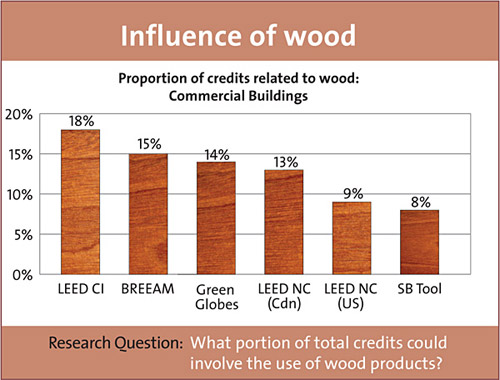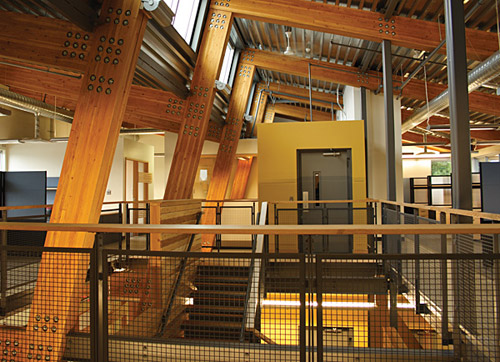Wood Rates: How Wood Products Stack Up in Green Building Systems
The study found that the prevalence of wood varied by rating system. Rating systems for single family homes in North America were the most inclusive of wood products: 25 percent of all credits in Built Green Canada for Homes involved the use of wood. Rating systems for commercial buildings and buildings outside of North America were the least inclusive: less than 10 percent of the credits in SB Tool, LEED NC US, and BREEAM Code for Sustainable Homes related to wood. In rating systems for commercial buildings, between 8 percent and 18 percent of the total credits related to wood, with LEED CI at the top of the range.
 |
|
Source: Light House Sustainable Building Centre |
The use of wood helped achieve six points in Canada's first LEED Platinum certified building, the Operations Center at Parks Canada's Gulf Islands National Park Reserve. The reserve, which includes 15 islands and inter-tidal areas between Victoria and Vancouver, British Columbia, completed its Operations Center in 2005. The use of Canadian Standards Association-certified (PEFC-endorsed) wood garnered points for the use of wood materials from local sources. Indigenous species were used for both finishes and structural application. Western red cedar, which has a strong historic and cultural importance locally, was used extensively for exterior cladding and sunscreens and finished with a water-based, clear finish that serves as a water-repellent shield and protects against ultra-violet (UV) degradation. Inside, cedar slat walls define the central stair and accent walls in other rooms. Douglas fir was used in glulam beams and columns that provide main structural support, and edge-grain Douglas fir for window and doorframes, casings and trim, and for the structural decking in the second-floor walkway bridges.
Wood finishes and structural members were finished with clear, water-based finishes with VOC content. In millwork and wood doors, clear birch veneer was used over formaldehyde-free substrates. Minimizing VOC emissions from all wood products - plywood, medium density fiberboard and solid core doors included - gained a point under indoor air quality. Though not eligible for LEED points, wood was the only structural and finish material that comes from a renewable resource. "The mandate of our client, Parks Canada, is the preservation of Canada's National heritage sites and they wished to demonstrate this commitment in their Operations Centre through the selection of sustainable/renewable building materials," says Larry McFarland, FRAIC, MAIBC, Principal, McFarland Marceau Architects Ltd., Vancouver, British Columbia. "Although LEED is a measuring device, it does not yet recognize the true environmental input of various construction materials of which wood is the only renewable one. We have not used other green building rating systems but advocate that all building materials should be held to the high level of accountability to which wood is subjected.
 |
Wood helped the Gulf Island National Reserve Operations center to achieve LEED Platinum status. Photo: Derek Lepper |









